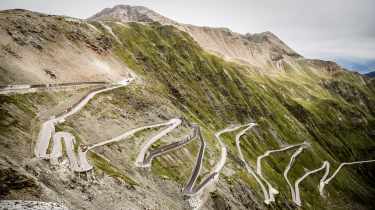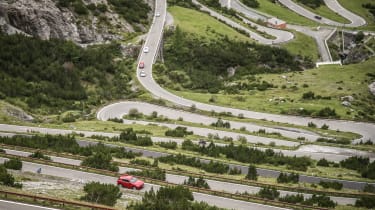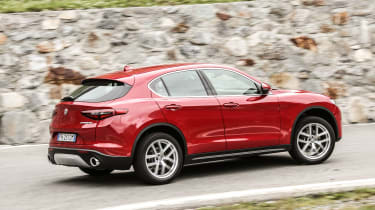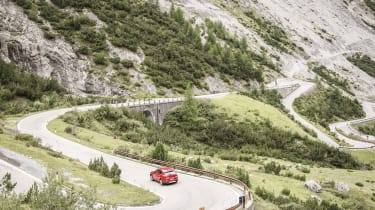Stelvio v Stelvio – Alfa’s SUV driven on the notorious Alpine pass
We take Alfa’s new SUV to what’s often purported to be Europe’s best driving road
In anything less than a Lancia 037 – one whose handbrake you’re particularly adept at using – the Stelvio Pass is going to be disappointing; even for a car named the Stevlio, sadly.
That is – mostly – the road’s fault. On one side it’s tight, twisty and full of people riding bikes, of both the push and motor variety. The other side, going down towards Bormio, is slightly less tortuous, the hairpins are less frequent, the road is well sighted and there are fewer bikes. However, it’s still very tight in places.
There is some fun to be had; stay locally in Bormio or Trafoi, the closest town north of the pass. Then you can wake up early to tackle the road when it’s quiet, before the tourists and cyclists have got there. If you’re lucky it’ll rain or be very cloudy in the morning and it’ll put off the hoards of lycra-clad fitness freaks for the entire day as well as the coach loads of sightseers all looking for scenic views.
What the road is best known for and what makes it so photogenic, its seemingly endless ladder of hairpins, is actually what makes on half of the Stelvio a nightmare for driving. A high number of 180-degree bends at the end of down hill stretches are going to create an issue for any car. Specifically, the brakes of any car.
But that does provide the perfect opportunity to put the Stelvio’s Integrated Brake System to the test. Rather than having a conventional vacuum powered brake booster, the Stevlio – like its close relative, the Giulia – uses an electric pump to build hydraulic pressure in the brake system. The electronic system can control the ABS and ESC too, so there isn’t a need for a separate unit for the safety systems, making it lighter. What’s most relevant on the Stelvio Pass is that IBS can compensate for the brakes getting hot and apply more and more pressure so the brake pedal is just as firm as when the brakes are cool.
But, although the Stelvio’s electronic, variable brake booster all but eradicates the feeling of brake fade well, what it doesn’t do is alter physics, and the brakes still get hot. The only sense of the brakes overheating then is from the acrid smell that fills the cabin, the grumbling and grinding noise they make, and by the smoke coming from within the front wheels. Because, sure enough, after a spirited drive down the really twisty side, which has an impressive 40 or so hairpins to deal with, the brakes are less effective, even though the pedal feels the same. It’s an achievement of sorts, but physical hints that the brakes are losing their effectiveness through your foot are actually quite helpful.
What does seem perfectly suited to the Stelvio Pass is the Alfa’s steering. It’s light and fast, and it means you can add a lot of steering very quickly to point it around the haipins. The chassis, impressively, reacts instantly when you turn in, too.
Mid-corner there’s a greater amount of weight through the wheel than on initial turn-in, and it’s more difficult to wind the lock off before the end of the corner. That sometimes results in a rather scruffy exit to a corner as you can’t get the steering perfectly straight quickly enough. This is exacerbated by the Stelvio’s high ride height and slight roll, because although the body stays flat as you turn in, it gently tips to the side at the apex of a corner and takes a little time to fully right itself.
But this is nitpicking, because the Stelvio is amazingly agile. On the narrow pass it feels suitably small and, although it’s a dreadful cliché, it genuinely feels as though it shrinks around you as you start to weave it up and down the mountain. Absolutely perfect for slipping past the eight billion cyclists.
Particularly useful when traversing the Stelvio Pass’s numerous switchbacks are its column-mounted gearshift paddles. I’ll be honest, most of the time I prefer paddles that move with the steering wheel; on most roads where you don’t use a lot of lock, or need to change gear half way round a corner, they always seem to be at the end of your fingertips. But the Stelvio’s large, aluminium, column-mounted gear change paddles are a boon on the hairpins. As you’re twirling the wheel from lock to lock, you always know where the paddles are as they haven’t moved in the meantime. Although your hands might be elsewhere, you instinctively know where to move them when you want another gear rather than searching behind the steering wheel for a paddle, hoping you get the desired one.
> Read our review of the Alfa Romeo Giulia Quadrifoglio
Choosing between a diesel or a petrol motor is usually pretty easy when fun and enjoyment are your criteria. You’d choose petrol every time. But both the road and the Alfa’s two engines create a unique situation that contradicts that typical judgment.
Firstly, the Alfa’s four-cylinder 276bhp petrol engine isn’t very exciting. With a redline starting at 5000rpm on the dial it certainly doesn’t promise a lot. It will actually spin to a more pleasing 6000rpm, but never emits a very evocative noise – it actually sounds more like a particularly refined diesel motor. There’s a healthy amount of mid-range performance, again like a diesel, but not enough for it to feel like a 5.7sec 0-62mph car.
The uninspiring petrol engine means that the 207bhp four-cylinder diesel isn’t as relatively disappointing. For starters, your expectations are lower for an oil burner, but it also feels less hesitant when climbing the mountain pass than the petrol. In second, with low revs as you crawl around the hairpins – you really can't carry much speed – the diesel responds immediately when you pounce on the throttle, where the petrol takes a moment or two to react. Combined with the eight-speed ZF auto, you can change gear often enough to keep the engine spinning between 3-4000rpm, just where it offers its greatest amount of shove.
Yet still, in a world of digital sound augmented motors, whether you like them or not, modern diesels have become aurally bearable as well as getting increasingly more potent as you rev them. The Stelvio’s 2-litre turbodiesel feels like a generation behind. Effective then, but noisy and unrefined; it’s not a particularly nice engine to use, but then neither is the petrol.
The Stelvio will, eventually, be available with the Giulia Quadrifoglio’s 2.9-litre 503bhp V6. Then, we’re sure, choosing the most fun engine in the Alfa SUV will be much easier, if not at all surprising. Until then the diesel Stelvio is the one you want for the Stelvio Pass, but for some real fun go searching for some quieter, more open mountain passes. Unless you have a rear-wheel drive Group B rally car and your name is Gigi Galli.







